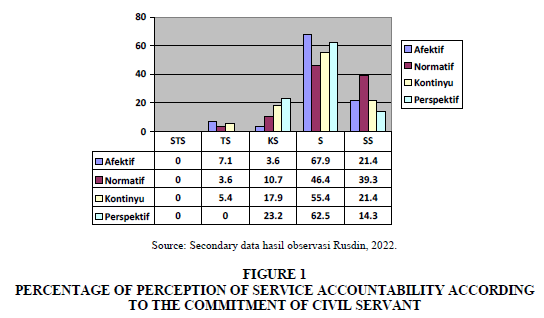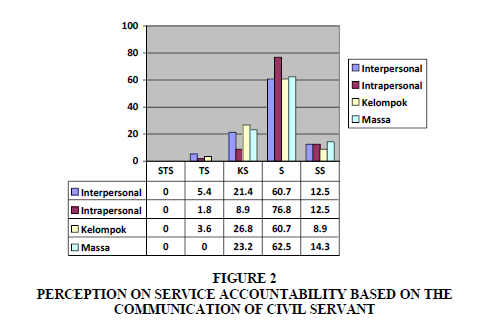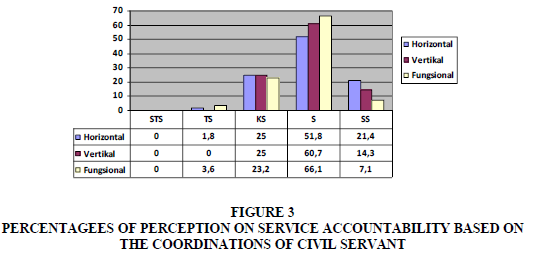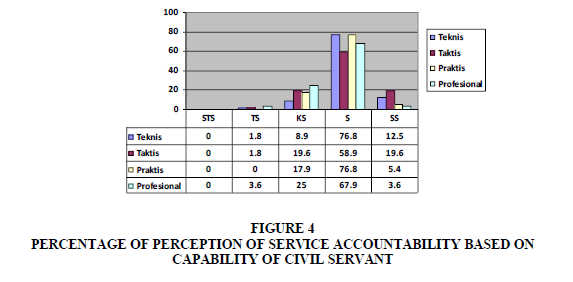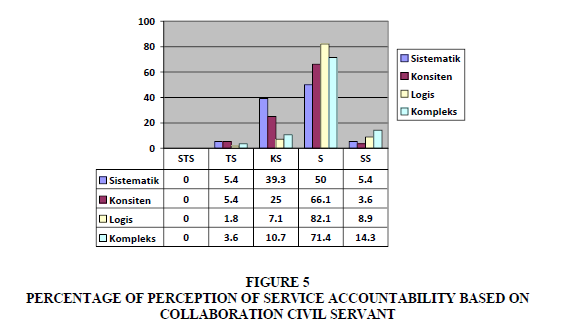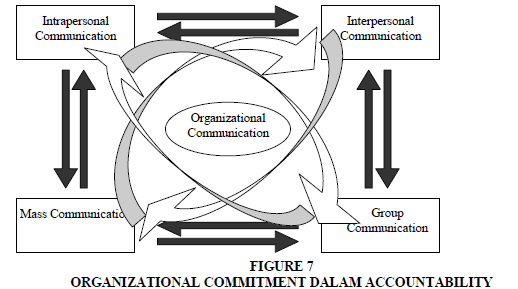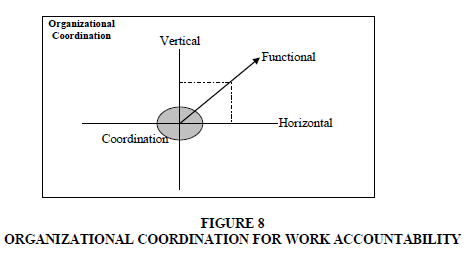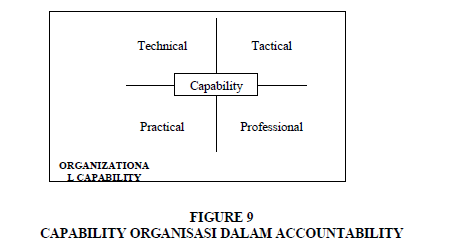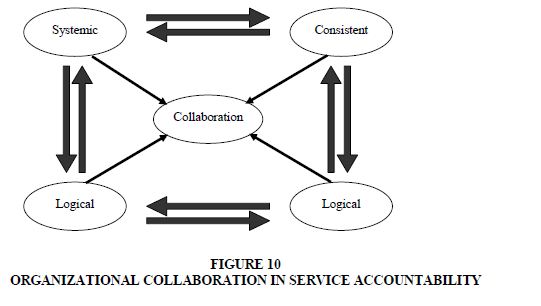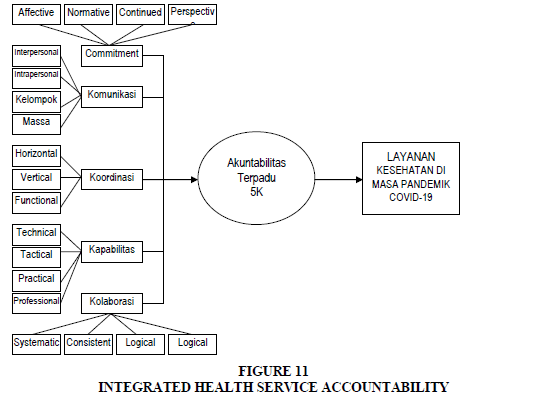Research Article: 2022 Vol: 25 Issue: 5
Service Accountability Government during a Pandemic at the Makassar City Health Office
Rusdin Nawi, Universitas Panca Sakti
Citation Information: Nawi, R. (2022). Service accountability government during a pandemic at the makassar city health office. Journal of Legal, Ethical and Regulatory Issues, 25(5), 1-16.
Abstract
The COVID-19 pandemic has posed challenges to the government officers to maintain the fulfillment of community needs for more integrated health services. Applying a qualitative approach, this phenomenology study encompassed stages from formulating problems, inquiring research questions, collecting relevant data and information, analyzing in detail the secondary data/information gathered from the observation, and providing meaning from both native and scientists’ viewpoints based on the result of in-depth interview and focus group discussion. The result of the study found that the Health Department of Makassar City implemented service accountability in the health sector embodied in commitment, communication, coordination, capability, and collaboration. The commitment of service accountability was actualized in practices upholding affective, normative, continued, perspective manners. The communication of accountability service was delivered through interpersonal, group, and mass channels. While the coordination of service accountability is performed horizontally, vertically, and functionally, the capability encompassed technical, tactical, practical, and professional measures. The collaboration in service accountability was conducted in systematic, consistent, logical, and complex manners.
Keywords
Model Accountability, Commitment, Communication, Coordination, Capability, Collaboration and Health Services.
Introduction
At the beginning of 2020, the medical world was astounded by the Coronavirus Disease or COVID-19 pandemic outbreak in Wuhan, China at the end of December 2019 that claimed many lives in Wuhan. The virus has spread into variants from Alpha, Delta, Gamma, and the latest one is Omicron. As of 24 September 2020, WHO reported that 215 countries were infected with the virus, confirming 31.425.029 cases and 967.164 lives succumbed to the disease (World Health Organization, 2021).
According to the Ministry of Health of the Republic of Indonesia, as of 25 September 2020 there were 262.022 confirmed cases, 10.105 death, 191.853 recovered, and 60.064 under medical care. The government has published policies to mitigate the spread of the virus. First, Government Regulation Number 21 of 2020 concerning the Large-scale Social Restriction (PSBB) to accelerate the Mitigation of COVID-19. Second, the government emphasized the implementation of PSBB in the Regulation of Ministry of Health No. 9 of 2020 on PSBB guidelines to accelerate the Mitigation of COVID-19.
The government of Indonesia has played its general role as the provider of services and human development and empowerment simultaneously to achieve the goal of governance. Government service aims to fulfill community needs and community welfare. Public service is the extended hands of the government to meet public needs (Rakhmat, 2017). Public services as the foundation of government policy-making need to focus on improving public service quality and welfare. In 2020, the accountability of public policies by the government services was deemed to have declined (Raba, 2006). The problematic public policies are those related to the mitigation and recovery initiatives as well as the new norm resulting from the COVID-19 pandemic around the globe, including Indonesia.
The government has started to rethink the worsening condition and formulate policies to reverse the situation. Accordingly, the government establishes better measures than PSBB, i.e., the new normal. The Ministry of Health (Kemenkes) published the Regulation of the Ministry of Health No. HK.01.07/MENKES/328/2020 on Guidelines for COVID-19 Prevention and Control at Workplaces and Industries in Supporting Business Sustainability amid the Pandemic. The success of new normal policies requires synergy and solid collaboration between the Central Government, Regional Governments, and the community to ensure the efficient fulfillment of health services.
Service accountability by the government, especially in the health service sector must remain optimum during the pandemic. The COVID-19 pandemic has posed challenges to the government officers to maintain and meet the community needs in the health sector by providing more optimum services. In response to this, the government published a policy through The Ministry of State Apparatus Empowerment and Bureaucratic Reform issued Circular Letter Number 58 of 2020 concerning the Work System of the State Civil Apparatus (ASN) in the New Normal Order which stated that the working system of the ASN needs adjustment to maintain the sustainability of duty and role fulfillment in state administration and public service to welcome the productive new normal free from the COVID-19.
The improvement of service accountability in the health sector is embodied in providing health care services to people in the new normal era and is considered essential. A new working system must be applied diligently to achieve goals and desirable results without disregarding the potential health risks of the medical staff and personnel who are directly involved in the COVID- 19 mitigation.
Higher accountability is required in the Acceleration of COVID-19 Mitigation in South Sulawesi, particularly Makassar City because the process involves multiple stakeholders from different government organizations, including local government officers, the Mayor of Makassar City, Regional Secretary, Head of Subdistrict, Head of Village, and Community. It is intended to synchronize and organize all programs currently undertaken. Coordinated program implementation refers to a harmonious, synchronized, and integrated manner in achieving common goals.
The success of a region, especially Makassar City to protect the community through COVID-19 mitigation, is not determined solely from the Department of Health but also the role of other intercorrelated institutions or stakeholders, such as the National Agency for Disaster Management (BPBD) of Makassar City, the Indonesian National Police (Polri), Indonesian National Army (TNI), Subdistrict Office, Village Office, and Municipal Police (Satpol PP), and community participation (Palit, 2020). Service accountability is one of the government measures to overcome health problems in the community.
In the real setting of governance, accountability is the key factor of the success or failure of a government playing its role. Accelerating COVID-19 mitigation takes accountability to handle and prevent overlapping services to fully utilize the allocated budget effectively and efficiently.
Service accountability is a form of accountability or fulfillment of a duty to the stakeholder bearing the rights or authorization to inquire for explanation or accountability. Cresswell (2015), states that every title-bearing officer must hold accountable to the organization. In other words, service accountability is a form of personnel responsible for their duty. It is mentioned that accountability is an authority given to someone to take responsibility according to their potential to the organization. Accountability is closely associated with an instrument of control, particularly when it comes to achieving results of public services and transparently reporting them to the community.
Service accountability is a matter of authority and responsibility bestowed to individuals, groups, or organizations. It is mentioned that accountability carries an essential meaning which is taking up authority and being held accountable to improve one’s work. Meanwhile, Turner and Hulme (2018) stated that the importance of horizontal and vertical accountability should be more emphasized in institutions in the public sector. Furthermore, accountability is defined as the capacity to answer to the higher authorities about the actions of a group of people to the wider community in an organization. Additionally, it is also mentioned that accountability is the embodiment of responsibility for the success or failure of an organization in achieving the goals and outcomes established through accountable media periodically.
This study implemented the 5C’s of accountability as a common approach to measure service accountability and the existence of an organization that includes commitment, communication, coordinating capability, and collaboration. The 5C’s is a concept of job appraisal to accomplish accountable work for the organizations and the public.
The substantial elements of 5C’s accountability are elaborated by Piano (2018) that each organelle plays its role according to the 5C’s value so that the desired service accountability can be achieved. The following sections will elaborate on the substantial construction of 5C.
Commitment is the pillar of work that guides each individual to commit to his job well to establish the desired accountability. The substantial factors of commitment are affective accountability (progress of the company), normative (obedience to the organization rules), and perspective (maintain the success of a company).
Communication is the embodiment of work needed by each individual to talk about and discuss the administrative tasks to gain service accountability. The outcomes would be the interpersonal, intrapersonal, group and mass communication.
Coordination is the embodiment of integrated work across individuals in performing and improving their work through accountable, desirable administration services. Coordination at work can be done horizontally, vertically, and functionally.
Capability is the embodiment of work where individuals have access to do their job and accomplish the desired service accountability. The significance of work capability includes technical, tactical, practical, and professional capability. Lastly, collaboration is the embodiment of integrated work for individuals to improve their duties and accomplish service accountability in orderly manners. The significance of collaboration will lead every civil servant to partake in systematic, consistent, logical, and complex work.
Research Method
We applied the qualitative method which, according to Sugiyono (2015) investigates, finds, describes, and explains the distinction of an object being researched based on scientifically accountable data and information. More specifically, we used the phenomenology approach to probe into the focus of our research through some observations on behaviour and meaningful information gathered. This study aimed to provide an in-depth explanation of the phenomena and show the importance of probing into data and information in the research. The steps of the research include formulating problems, inquiring research questions, collecting relevant data and information, analysing in detail the secondary data/information gathered from the observation, and providing meaning from both native and scientists’ viewpoints based on the result of indepth interviews and focus group discussion.
Results and Discussion
Improving accountable public bureaucracy in the health sector must be supported by excellent human resources (Kumorotomo, 2005). It is relevant with the effort to accomplish an integrated, accountable public bureaucracy (Raba, 2006). The result of this study showed that service accountability in the health sector must be performed consistently and efficiently based on its duty and responsibility to provide health services to the people. Particularly in the pandemic era, it is a huge challenge for the government to provide the best solution in health services.
Our findings showed that the implementation of service accountability in the Health Department of Makassar City has encompassed the commitment, communication, coordination, capability, and collaboration elements. The detailed elaboration below is based on the results of direct observation and comparative model references related to accountability.
Commitment
The commitment of civil servants to perform their main duties properly and responsibly is an element of service accountability. The commitment here refers to affective, normative, continued, and perspective manners when providing health service in the pandemic era. The Figure 1 below illustrates staff perception of commitment to providing services in the pandemic.
Figure 1: Percentage Of Perception Of Service Accountability According To The Commitment Of Civil Servant.
Figure 1 shows the perception of commitment of civil servants based on four shows that they agreed to all affective, normative, continued, and perspective commitments with a score ranging from 46.4% to 67.9%. It indicates that civil servants have more committed to accomplishing service accountability in the health sector during the pandemic.
Furthermore, the results of the interview and the conclusions of the Focus Group Discussion (FGD) have reinforced this result as shown in the Table 1 below.
| Table 1 Matrices OfCommitment Health Service Accountability |
|||
|---|---|---|---|
| Commitment | Ethic Approach | Emic Approach | FGD |
| Affective | Providing the best public health services amid the pandemic | Multiple policies in health services have been implemented to the public | It takes a strong commitment to obey, advocate, and retain to accomplish service accountability in health sector for public |
| Normative | Obey the rules based on the instruction of the Central Government down to the Village Office to provide public health services | Obey the regulations and policies of the government consistently | |
| Continued | Advocate the best regulations and policies in public health services | Consistency with the leaders policy guideline to follow up the public services | |
| Prospective | Retain all integrated policies in health services to the public | Public services as the orientation to embody the quality health services | |
Source: Result of the Interviews, 2022
The matrix above on the commitment of health service accountability indicates the significance of high commitment and accountability in health services.
Communication
Service accountability from communication viewpoint must be implemented correctly amid the pandemic. In this case, communication must be delivered and realized properly to all civil servants so that they can extend this communication through interpersonal, intrapersonal, group, or mass channels.
Below is the graphic of secondary data on the perception of communication in service accountability:
Figure 2 indicates that generally, the perception of civil servants with four-item evaluative questions show that the civil servants shared agreeable perceptions to all categories of interpersonal, intrapersonal, group, and mass communication with a percentage from 60.7% to 76.8%. The fact that the percentage is above 50% shows that the civil servants have implemented proper communication as part of service accountability, but there remains room for improvement.
The secondary data was reinforced with the results of interviews and conclusions of the Focus Group Discussion (FGD) as presented in the matrix below Table 2:
| Table 2 Matrix Of Communication Health Service Accountability |
|||
|---|---|---|---|
| Communication | Ethical Approach | Emic Approach | FGD |
| Interpersonal | Communication between two people or more about health services has been actualized in the public | Integrated and transparent information regarding health services has been communicated to the public | Intensive communication is maintained to engage the public in the program and activities related to health services |
| Intrapersonal | Personal communication when providing services has been delivered empathetically to the public | Empathetic services are the embodiment of response and sensitivity to deliver information regarding health services | |
| Group | The department and staff actualize the integrated health services | Health Department continuously feeds the public with transparent information about health services | |
| Mass | Create intensive advertising and health campaign for public | Raise public awareness through mass communication | |
Source: Result of the Interviews, 2022
The matrix above concludes that public communication for programs and activities related to health services must be done in a transparent and integrated manner.
Coordination
Service accountability in terms of coordination is the actualization of work performed by the civil servant in improving and collaborating responsibly to provide services in health sector. The coordination includes horizontal coordination, vertical coordination, and functional coordination.
The graphic below shows the percentage of perception based on the coordination indicator of service accountability.
Figure 3 shows that in general, the coordination indicator with three iindicates that all participants agree with horizontal, vertical, and functional coordination (51.8%-66.1%). The >50% score shows that the civil servants have performed sufficient coordination as a form of service accountability and there remains room for improvement.
Figure 3: Percentagees Of Perception On Service Accountability Based On The Coordinations Of Civil Servant.
The secondary data are reinforced with the result of interviews and conclusions of the Focus Group Discussion (FGD) presented below in Table 3:
| Table 3 Matrix Of Coordination Health Service Accountability |
|||
|---|---|---|---|
| Coordination | Ethical Approach | Emic Approach | FGD |
| Horizontal | Civil servant and colleague must work hand in hand to provide the best service for public | Team work is the key to success of health services | Teamwork, integration, interests, and goals are the essential values of public health service coordination |
| Vertical | Leaders and subordinate must consistently provide proper health services | Leadership style affects the subordinates to give their best services | |
| Diagonal | Leaders, subordinates, and partners support each other to provide health services | Interests and goals determine the success of public health services | |
Source: Result of the Interviews, 2022
The matrix above regarding the coordination of health service accountability concludes that successful coordination translates to collaborative efforts from the leaders, subordinates, colleagues, and partners to develop common interests and goals to achieve integrated health services.
Capability
Service accountability refers to the actualization of capacity and skills of the civil servants to work according to their responsibility. Capability here encompasses technical, tactical, practical, and professional. The graphic below based on secondary data illustrates the percentage of perception on capability of service accountability.
Figure 4 shows that the capability indicator with four-item evaluative questions indicates that all participants agree that they have performed technical, tactical, practical and professional coordination (51.8%-66.1%).
The >50% score shows that the civil servants have performed sufficient capability as part of service accountability, but there remains room for improvement.
The secondary data are reinforced with the result of interviews and conclusions of the Focus Group Discussion (FGD) presented below in Table 4:
| Table 4 Matrix Of Capability Health Service Accountability |
|||
| Capability | Ethical Approach | Emic Approach | FGD |
|---|---|---|---|
| Technical | Using all service facilities to provide ease of service to public | The existing facilities are technical instruments to support the success of health services | Everyone is required to work according to their capability for a placement that conforms their capacity, skills, and mastery |
| Tactical | Perform the main duties based on the regulations of the organization and the policies set forth by the leader to provide consensual health services to public | Efficient and effective regulations and policies would determine the tactical delivery of public health services | |
| Practical | Provide services according to the needs, expectation, and goals of public health services | Provide quality and satisfactory services | |
| Professional | Preforming their professional role according to the ethical code approach in health service delivery | Work according to duties and professionalism | |
Source: Result of the Interviews, 2022
The matrix above shows that every public servant has been in the right place according to their capability in service accountability, including health service sector.
Collaboration
Service accountability in terms of collaboration is the attitude of civil servants in improving their work consistently, orderly, and collectively in order to accomplish service accountability. The collaboration here encompassed the systematic, consistent, logical, and integrated elements.
The graph below shows the percentage of perception based on the collaboration indicators in service accountability:
Figure 5 shows that the collaboration indicator with four indicates that all participants agree that they have performed systematic, consistent, logical, and integrated (50%-82.1%). It shows that the civil servants have performed and needed to maintain sufficient accountability.
The secondary data are reinforced with the result of interviews and conclusions of the Focus Group Discussion (FGD) presented below in Table 5:
| Table 5 Matrix Of Collaboration Health Service Accountability |
|||
|---|---|---|---|
| Collaboration | Ethical Approach | Emic Approach | FGD |
| Systematic | Perform main duties according to systems, SOP, and ethical code approach in public health services | Sistematika kerja sebagai syarat and kelayakan dalam memadukan public service yang terbaik | Provide collaborative services in systematic, consistent, logical, and integrated manner to achieve integrated health services |
| Consistent | Implement the system and regulations of services according to the existing standard operational procedure and consensus. | Consistency with organizational regulations and leaders policy in service delivery | |
| Logical | Work with logical consideration and rational dedication during service delivery | Actualize every service activity according to steady and logical consideration | |
| Integrated | Perform duties in integrated and organized manners while pertaining future orientation continuously | Integrated and thorough work to achieve the goals of health services | |
Source: Result of the Interviews, 2022
The matrix above concludes that each service must be delivered systematically while taking into account consistent delivery that is logical and integrated to the service complexity.
Discussion
Based on Result of the Interviews and FGD recommendation, below is the detailed discussion on health service accountability in Indonesia.
The implementation of 5C’s pillar (or 5K in Bahasa Indonesia), is crucial for an organization to perform its function and establish service accountability. Regarding commitment, Smith et al. (2022) stated that organization commitment consists of affective commitment, normative commitment; continue commitment, and perspective commitment, as illustrated in the Figure 6 of accountability as follows:
In light of effective organizational communication, it is stated that organizational communication is message delivery from the communicators to the recipients to understand the aims and purposes of the communication. Communication may be embodied in interpersonal communication, intrapersonal communication, group communication, and mass communication. This multiple embodiment is intercorrelated to affect the actualization of service accountability. The clearer picture is illustrated below (Figure 7).
The next accountability model is coordination which is crucial for an organization to achieve accountability. Every civil servant in an organization must retain coordination one another. There are three embodiment of coordinations in an organization, i.e., horizontal, vertical, and functional coordination, as illustrated in the Figure 8 below.
The next accountability model is capability, which refers to the capacity of all resources owned by an organization in performing duties and responsibilities to maintain accountability. Technical, tactical, practical, and professional capabilities play important roles in organization as illustrated in the Figure 9 below.
The last pillar of accountability is collaboration, which is the attitude and action of human resources in an organization to perform all working activities in systematic, consistent, and logical manners to accomplish service accountability. The progressive and modern workplace is inseparable from collaboration performed systematically, consistently, and logically in an integrated system. Below is the illustration of collaborative working in an advanced, modern organisation.
The progress and modernity of the world of work cannot be separated from systemic collaboration logically and logically in an integrated complex. The following shows the Figure 10 of collaboration work in an advanced and modern organization:
These models produce a new model found by Rusdin (2022), namely an integrated health service accountability illustrated below:
Integrated health service accountability is an outcome of multiple literature reviews. The concept of integrated accountability or known as the 5C’s of accountability according to the founder, Piano (2018) refers to five elements of public accountability of an organization, namely commitment, communication, coordination, capability, and collaboration. This concept is employed by the organization to evaluate work outcomes or accountability. Meanwhile, Turner and Hulme (2018) reported that accountability is the key to taking responsibility for the work performed.
Accountability is inseparable from commitment. Rakhmat (2017) stated that commitment is part of the administrative behavior of an individual in an organization that embodied public accountability to accomplish organizational goals. Anayochukwu et al. (2022) reported that affective, normative, continued, and perspective commitments are crucial to accomplish public accountability. Similarly, this study found that commitment in health services must be organized toward better organizational services with an ethical approach, sustainability, and orientation towards excellent services (Figure 11).
Miller & Barbour (2014) mentioned that public accountability is inseparable from organizational commitment. The key success of an organization to accomplish its goals is associated with communication as a vital instrument (Mumby & Kuhn, 2018; Wrench et al., 2015). This opinion is relevant to the significance of communication as part of accountable health services. Furthermore, Baker (2017) found that interpersonal, intrapersonal, group, and mass communications define effective communication in effective service to accomplish public service accountability. It is in line with the findings of the present study that communication is the essential instrument as part of accounting services to reach organizational goals and public interests.
Developing organizational services always takes coordination from one element to another (Raba, 2006). The dynamics of coordination are embodied in horizontal, vertical, and functional coordination in public accountability (Jirsa & Kelso, 2004). Each element of coordination is integrated into the accountable system (Wijesekera, 2008) and shows the importance of institutionalized, integrated, and systematic coordination in organizational dynamics that is embodied in the service programs and activities and reported by Vrijhoef (2021). It is in line with the findings of the present study that coordination is an element in the accountability model to deliver consistent and accountable services.
Capability actualization should be owned by an organization to demonstrate accountability. Comim et al. (2008) stated that the most important potential in an organization is the capability that is easy to actualize. The crucial meaning of knowledge, innovation, and progress capability is embodied in organizational accountability (Annique, 2017). As reported by Osmani (2021), the capability is the organizational capital to address prospective capability to achieve public accountability. It is in line with the present study that an organization must perform technical, practical, tactical, and professional capabilities based on knowledge, innovation, and progress.
At last, collaboration is a part of public accountability. According to Morgan (2018), organizational collaboration is essential to accomplish goals. Accordingly, teamwork needs an integrated collaboration (Lasater, 2022) that is systematic, consistent, logical, and integrated (Di- Domenico et al., 2020). The core of organizational collaboration is strengthening accountability that is established consistently in an organization, which according to Opara et al. (2021) enables solid teamwork to achieve organizational goals. This past finding has confirmed the present study that accountability of public health services would be accomplished more easily when there is a systematic collaboration with a specific working procedure, consistency in implementing policies properly and logically.
Conclusion
The Health Department of Makassar City has implemented accountability in the public health sector in all five elements, i.e., commitment, communication, coordination, capability, and collaboration. The commitment has been actualized in affective, normative, continued, and perspective manners in service deliveries. Communication in accountability has been conducted online instead of offline during the pandemic. Internet as an online medium of communication has enabled the delivery of administration services through interpersonal, intrapersonal, group, and mass media channels.
Coordination in service accountability is embodied and implemented through horizontal, vertical, and functional measures when delivering services according to the main duties of health services. Capabilities in service accountability translate to the capacity of civil servants to perform and organize services in technical, tactical, practical, and professional manners. Finally, collaboration is implemented as crucial consideration to promote the embodiment of optimal health services in systematic, consistent and logical manners.
References
Anayochukwu, G.I., Ani, V.A., & Nsah, B. (2022). Assessment of local government autonom and governance: A case study in Nigeria. Journal of Governance and Accountability Studies, 2(1), 15-28.
Indexed at, Google Scholar, Cross Ref
Annique, U.C. (2017). Capability, knowledge, and innovation: strategies for capability development and performance.
Baker, K. (2017). Organizational communication.
Comim, F., Qizilbash, M., & Alkire, S. (2008). The capability approach: Concepts, measures and applications.
Indexed at, Google Scholar, Cross Ref
Cresswell, J.W. (2015). Qualitative research & Research design: Choose between five approaches. Yogyakarta: Student Library.
Di-Domenico, M., Vangen, S., Winchester, N., Boojihawon, D.K., & Mordaunt, J. (2020). Organizational collaboration: Themes and issues.Routledge.
Jirsa, V.K., & Kelso, S. (2004). Coordination dynamics: Issues and trends. Springer Science & Business Media.
Indexed at, Google Scholar, Cross Ref
Kumorotomo, W. (2005). Public bureaucratic accountability: A vignette in the transition period. UGM MAP & Student Library.
Lasater, I. (2022). Collaboration in the workplace: A guide for building better teams. Published by Goodreads.
Miller, K., & Barbour, J. (2014). Organizational communication: Approaches and processes. Cengage Learning.
Morgan, J. (2018). The collaboration organization. Published by McGraw Hills.
Mumby, D.K., & Kuhn, T.R. (2018). Organizational communication: A critical introduction. Sage Publications.
Opara, M., Okafor, O.N., Ufodike, A., & Kalu, K. (2021). Institutional entrepreneurship: Collaborative change in a complex Canadian organization. Accounting, Auditing & Accountability Journal, 34(9), 284-314.
Indexed at, Google Scholar, Cross Ref
Osmani, S.R. (2021). Coping with Covid-19 from the capability perspective: A view from a developing country. Journal of Human Development and Capabilities, 22(1), 1-26.
Indexed at, Google Scholar, Cross Ref
Palit, C.L. (2020). Coordination of the communication forum of District leaders in preventing the spread of the corona virus (Covid-19) in Kalawat District, North Minahasa Regency. Journal of Politico, 9(3), 1-18.
Piano, M. (2018). The element of accountability development. Ithaca: Cornell University Press.
Raba, M. (2006). Concept and implementation accountability. Cetakan Kedua, Penerbit UMMPress.
Rakhmat, M. (2017). Public administration and accountability.
Smith, E.M., Rakestraw, C., & Farroni, J.S. (2022). Research integrity during the covid-19 pandemic: Perspectives of health science researchers. Accountability in Research.
Indexed at, Google Scholar, Cross Ref
Sugiyono. (2015). Quantitative and qualitative research methods and R&D. Bandung. Publisher: CV Alfa Beta.
Turner, B., & Hulme, M. (2018). The frontiers of accountability model. London: Tavistock.
Vrijhoef, H.J. (2021). Changing perspectives: From care coordination to health coordination. International Journal of Care Coordination, 24(3-4), 89-90.
Indexed at, Google Scholar, Cross Ref
Wijesekera, R.D. (2008). Coordination compounds: Bonding, structure, and nomenclature. Alpha Science International Limited.
World Health Organization. (2021). Developing of Corona Virus Disease 19.
Wrench, J.S., Punyanunt-Carter, N., & Ward, S.M. (2015). Organizational communication: Theory, research, and practice. Flat World Knowledge: Washington, DC.
Received: 11-May-2022, Manuscript No. JLERI-22-11981; Editor assigned: 13-May-2022, PreQC No. JLERI-22-11981(PQ); Reviewed: 25-May-2022, QC No. JLERI-22-11981; Revised: 23-Aug-2022, Manuscript No. JLERI-21-11981(R); Published: 30-Aug-2022
